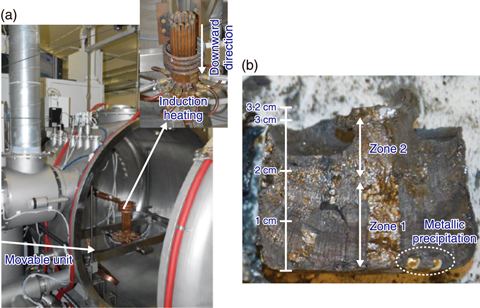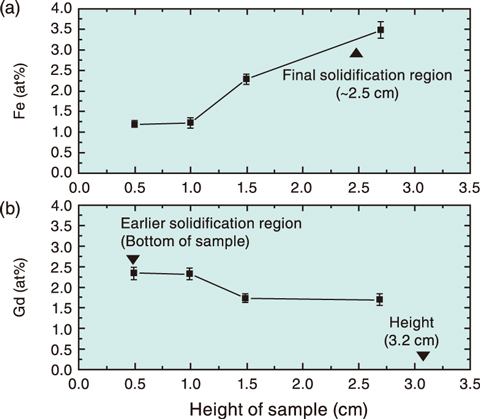
Fig.1-3 (a) View of the cold crucible induction furnace and (b) Cross-sectional image of sample

Fig.1-4 Solidification progress of simulated debris

Fig.1-5 (a) Dependence of (a) Fe and (b) Gd concentration on sample heights
During the severe accident at the TEPCO’s Fukushima Daiichi NPS (1F), molten corium consisting of nuclear fuels and structural materials (main component: iron (Fe)) may have formed and solidified at an extremely slow cooling rate. Components in the melt are likely to segregate under slow solidification. Gadolinium oxide (Gd2O3), a burnable poison, is present in a limited number of doped uranium dioxide (UO2) fuel rods owing to the high neutron capture cross-section. From the viewpoint of nuclear criticality safety, it is important to understand the distribution of Gd in the fuel debris. Additionally, an understanding of the distribution of Fe is also important because a significant amount of Fe may be potentially dissolved in the fuel debris and Fe is expected to influence criticality.
To investigate the segregation of Gd and Fe in the fuel debris, a liquefaction/solidification test on simulated core materials (containing UO2, ZrO2, Gd2O3, FeO, and simulated fission products MoO3, Nd2O3, SrO, and RuO2) approximately 1 kg in weight was performed using a cold crucible induction furnace (Fig.1-3(a)). The melted sample was gradually lowered during the test to achieve slow solidification conditions.
A cross-sectional image of the solidified sample is shown in Fig.1-3(b); here, the bottom region has a layered structure (zone 1) and the upper region has several cavities (zone 2). A schematic of the solidification progress is shown in Fig.1-4. The melt solidified gradually from the bottom-forming layered structure (zone 1). Subsequently, the upper crust was formed. Cavities were also formed during solidification toward the inner region. Additionally, Ru metal was precipitated in the bottom region.
Several pieces were obtained from the central axis of the sample from the top to the bottom regions and subjected to elemental analysis. The resulting concentrations of Fe and Gd in the sample are plotted as a function of sample height in Fig.1-5. The maximum concentration of Fe was 3.5at% at 2.7 cm, close to the estimated final solidification region. This suggests that Fe was segregated in the inner region of the fuel debris, where the melt was solidified later (Fig.1-5(a)). In contrast, the maximum concentration of Gd was 2.4at% at 0.5 cm. This position is close to the bottom of the sample, where the melt was solidified earlier, thus indicating that Gd segregates in the outer surface of the fuel debris. Because the number of Gd-doped fuel rods in a reactor is limited (approximately 1%), slight segregation can affect the recriticality of fuel debris (Fig.1-5(b)).
Although the liquefaction/solidification test of simulated core materials of approximately 1 kg was performed in this study, the mass of the fuel debris in 1F is predicted to be several tons or more. There is thus a large scale gap between the sample studied and 1F debris. Future research will include a larger-scale test (approximately 10 kg) and numerical analysis of segregation to acquire more reliable data on the segregation of components in fuel debris. These data will contribute to the future removal of the fuel debris.
This study was performed joint research between JAEA and Research Centre Řež on “Preliminary tests on molten corium solidification mechanism”, and Japan Times has introduced about the article of good cooperative relationship between Japan and Czechia.
(Ayako Sudo)